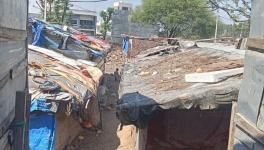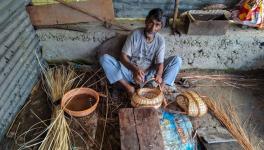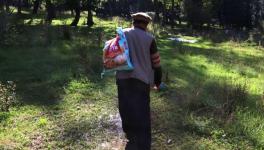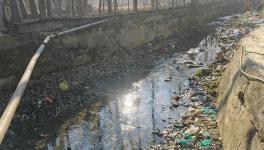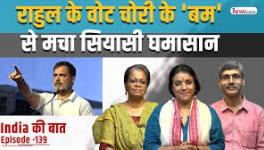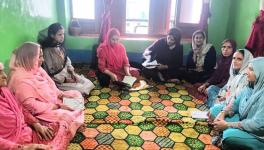Killings of Civilians: Spectre of Nineties in Kashmir?
Sikh mourners carrying the body of Supinder Kaur, a school principal, who was killed yesterday at her school.
Photo By Kamran Yousuf
The recent civilian killings in Kashmir have created a furore in Indian political and civil circles. They indicate a new and dangerous pattern of terrorist activities in the valley. They also put a serious question mark ahead of the official claims of normalcy by the Centre during and after the abrogation of Article 370 and revocation of statehood of Jammu and Kashmir. The mainstream media is busy portraying the killings as communal, but they are a product of complex factors. Any generalisation might lead to wrong, even disastrous, conclusions.
The incidents:
The latest killing spree in Kashmir has been on for more than six months, of which October was the bloodiest. Militants chose Gandhi Jayanti, the international day for non-violence, to kill two employees of the Power Development Department, Abdul Majeed Gojari and Muhammad Shafi Dar, in separate incidents. These killings found no space in the national media.
The national media came into action only three days later, when militants killed well-known chemist Makan Lal Bindroo at his shop in a high-security zone of the Iqbal Park area. Then followed the killing of a non-local roadside Bhelpuri vendor, Virendra Paswan, at Lalbazar, Srinagar. In a third attack, militants shot dead a civilian named Mohammad Shafi Lone in north Kashmir’s Bandipora district.
The killing of a prominent and non-political Kashmiri Pandit businessman ML Bindroo shocked even those who have observed civilian killings rise in the last six months. Rakesh Pandita, a Kashmiri Pandit, was also killed in June, but many called it a political murder since he was a BJP worker and elected Panch. However, Bindroo had no political connection and was among the 800-odd families who decided to stay in Kashmir during the 1990s. No member of this micro-minuscule minority was hurt over the last decade-and-a-half, so this incident has sent shock waves across the community. Sanjay Tickoo, who leads the association of resident Kashmiri Pandits, the Kashmir Pandit Sangharsh Samiti (KPSS), called it a return of the 1990s.
Even more critical was two other minority community members killings the very next day. On Thursday morning, gunmen shot dead Deepak Chand, a school principal and a Dogra from Jammu, and a Sikh female teacher, Supinder Kour, in the Safa Kadal area of Srinagar. There are about 30,000 Sikhs in the Valley.
In a statement to ANI, Vijay Kumar, IGP, Kashmir, said, “During 2021, so far, 28 civilians have been killed by terrorists. Out of 28, five persons belong to the local Hindu/Sikh community and two non-local Hindu labourers.” The police chose not to mention the Kashmiri Muslims who were killed, but it is apparent that the remaining 23 civilians belonged to the majority Muslim community. In most of these cases, none of the well-known terrorist organisations took responsibility. Instead, unknown outfits such as the People’s Anti-Fascist Front said to be an offshoot of the Lashkar-e-Toiba, and The Resistance Front claimed some of the killings.
Many police officers have also been attacked and killed over the last few months. In September, two policemen—Bantu Sharma from Handwara and Arshid Ahmad Mir from Khanyar—were killed in separate incidents. On 17 June, a policeman, Javeed Ahmed Kambey, was killed outside his house in the Saidpora area of Srinagar. A senior police officer, Parwez Ahmed Dar, was killed on 22 June while returning from a mosque in the Kanipora area. Three days later, militants barged into the house of SPO Fayaz Ahmad Bhat and killed him, his wife and daughter in cold blood.
Along with other such incidents in the past six months or so, there have been political killings in Kashmir. On 8 July 2018, 28-year-old Shiekh Waseem Bari, a former district president of the BJP in Bandipore, and his father and brother were killed. The family had ten security personnel, who were unfortunately not present at the time. Two more BJP members, sarpanch Sheikh Sajad Ahmed and Abdul Hamid Najjar, were killed at Vessu in Qazigund and Ompora in Budgam. The government beefed up security considerably after these incidents, but an “unidentified gunman” struck again, killing Bhupinder Singh, the Sikh Block Development Council chairman at Khag on 23 September. Three Muslim BJP activists were attacked at YK Pora in Kulgam on 29 October. “Unidentified gunmen” also attacked BJP leader Ghulam Qadir, who retaliated and survived. His PSO and one assailant, later identified as Shabir Ahmad Shah from Tral, were shot dead. A councillor, Riyaz Ahmad Peer, and his SPO, Shafqat Nazir, were killed in March 2021 in Sopore. His father-in-law Shamsuddin Pir was injured in the firing. A BJP councillor from South Kashmir, Rakesh Pandita, was killed on 2 June.
Claims, the truth, and frustration
Home minister Amit Shah and his supporters had claimed that abrogating Article 370 and Jammu and Kashmir’s statehood would wipe out militancy from the valley. They made similar claims when they imposed demonetisation on the nation, too. For several years, BJP has claimed that militancy in Kashmir results from previous governments’ policies and that they will ensure its end and the return of Kashmiri Pandits. These claims recur in every election campaign and are a favourite of right-wing internet warriors. They are repeated with such zeal that most people outside the valley seem to believe and endorse them.
Since the fall of the PDP-BJP coalition government, the central government has been in complete control of the valley. They have an absolute majority in Parliament, President's rule in J&K, a BJP man as the Lieutenant-Governor, and a favourable media that seldom publish anything but government press releases. Naturally, we must ask the central government why these killings still occur. The attempt to conceal the failure of the state and central machinery to secure innocent citizens in the garb of communal propaganda is sinister. Whatever the claims, the truth is that citizens’ lives in the valley are in danger, and the minorities are more vulnerable.
The larger truth is the frustration that engulfs the ordinary people of the valley. Development is a mirage, never within grasp outside official press conferences. There has been no representative government for close to two-and-a-half years. There is no free press to raise people’s grievances, and there is an ever-growing deployment of armed forces. This absence of democratic processes has created an autocracy-like rule with decisions taken solely to suit the Center's agenda. The iron hand was always there in Kashmir, but the situation is turning from bad to worse without the safety valve of local leadership.
The land disputes:
On 8 September, the Lieutenant-Governor launched a portal to redress the grievances of migrant Kashmiri Pandits regarding their properties in the valley. This portal registers their complaints about distress sales, encroachments or other property-related grievances in the Union Territory. (Kashmiri Pandits have repeatedly claimed that locals encroached on their properties after they migrated. In 1997, the J&K government passed the Jammu and Kashmir Migrant Immovable Property (Preservation, Protection and Restraint on Distress Sales) Act, 1997, to preserve, protect and restrain distress sales of immovable properties of Pandit migrants. Last March, for speedy redress, the government did away with a requirement of filing written complaints about surveys or measurements of migrant properties (proviso 2 of sub-section (2) of section 6). The new portal sought to speed up this process further.
No doubt, the Pandits lost many properties in the valley due to migration. There were encroachments and distress sales across the valley, and restoring these is a prerequisite for the Pandits to return to Kashmir. But it will only succeed if the state takes people into confidence. Thirty years is a very long time, and coercion will only widen the gap and trust deficit between the two communities. Sadly, this is what has happened in Kashmir ever since the government launched this portal. Many locals complained of false claims, calling legal sales distress sales and coercion to forfeit their properties. The mainstream media in Kashmir has not reported on such incidents, but lesser-known news sites regularly report them.
A few Salia, Kulgam and Srinagar locals said on condition of anonymity that many houses have been bulldozed and properties attached; tehsils ordered to take strict action. Some faced hefty fines, too. The resultant unease among the majority community could be a reason for some of the targeted killings this week. It is difficult to establish a direct link between the two, but many, including Sanjay Tickoo, claims the property issue is a trigger point.
Militants killed, but all is not well:
Undoubtedly, the Army and paramilitary forces have quite effectively annihilated major terrorist groups. The once-dominant Hizbul Mujahideen is nearly gone from Kashmir after Riyaz Ahmed Naikoo was killed in an encounter with security forces last year. A large number of terrorists have been killed, and, to an extent, infiltrations controlled too.
Yet, the recent killings prove, once again, that the state cannot control such activities through might alone. Senior police and army officers have publicly accepted that recent incidents are the handiwork of home-grown terrorists: young, untrained men with unsophisticated weapons, who easily mingle with the local population, mark soft targets and engage in a sort of guerrilla warfare. Local support, which provides them cover, cannot be denied either.
Local frustration, arising from autocratic policies and denial of democratic space, creates such an atmosphere—revolt can manifest only in its uglier forms. There is an impression in Kashmir that the Centre is hell-bent on bringing outsiders into the valley. This perception is fuelled, time and again, by statements of political leaders and the social media posts of their supporters. These killings may be an attempt to trigger warnings and manifest frustrations. While police officers and political leaders have been killed for being a part of government machinery, Kashmiri Pandits, or Hindus from outside Kashmir, or others, are killed because they are presumed to be pro-establishment. An element of communal hatred behind these killings also cannot be denied.
Return of the nineties?
Sanjay Tickoo has said that such incidents have been expected since August 2019. In October 2019, he categorically told me that the abrogation of Article 370 and revocation of statehood would make the lives of resident Kashmiri Pandits more difficult. ‘You might not find me in Srinagar on your next visit,’ he said to me. When I called him this week, he was concerned about the security of Kashmiri Pandits in the valley. He said a few Pandit families had moved to safer places. However, if the situation improves, they will return.
Kashmiri Pandits are a microscopic, almost invisible, minority in the valley. However, just to mainstream the migrants, the media and administration use the ridiculous “non-migrant Pandits” appellation for them. The migrant population grabs media attention, while the residents hardly seem to matter. Even their migrant brethren fought pillar to post to exclude them from the Prime Minister Package announced for Kashmiri Pandits during the second term of the UPA government. When Sanjay Tickoo and Kashmiri Pandits undertook a fast unto death last year, no political party supported them except some National Conference leaders. The national media maintained complete silence over their protest.
Remember, security was not an important issue for Kashmiri Pandits in the valley for the last decade-and-a-half. Living silently and going about their business, they had acquired legitimate sympathy from their neighbours. But the abrogation of Article 370 and corresponding celebrations by Kashmiri Pandits across the world changed the situation.
In June, after the Wagoora Nowgam encounter on the outskirts of Srinagar, anonymous Facebook posts and tweets had emerged, holding a pharmacist (from a minority community) responsible for the killing of a militant from Shopian. The miscreant was immediately nabbed and the social media accounts removed, but this incident indicates the animosity of a section of the radicalised Kashmiri population towards Pandits. So, while it is too early to call the current situation a “return to the nineties”, yet the trends are dangerous. For instance, even in the 1990s, the militants never targeted schools.
As is evident, the recent killings are the handiwork of a few unorganised radical youths, but if not controlled, it could spread. As a micro-minority living under constant pressure, with ugly memories of the horrific nineties, even one such killing can make waves of panic ripple across the community. Now is a critical moment when an incident could send the situation out of control. That such incidents can recur cannot be ruled out.
Any exodus of Kashmiri Pandits will hurt their existence and identity, and the government must prevent it, along with the government, civil society, and the political class of the valley. It is heartening that almost every political party came forward to condemn the killings, but that is not enough. The government must come forward to ensure the security of each citizen.
Might more often wrong than right:
The last 30 years of events in Kashmir have reflected how force is insufficient to control violent rebellions. Time and again, the state has crushed terrorist organisations and put their supporters behind bars innumerable times. Curfews and CASO have been regular exercises, and elected governments abruptly sacked. None of these can provide permanent peace in the valley. Rebellion has reoccurred, reminding of the mythical character of Raktbeej: Every time blood is spilt, it creates new radicals, terrorist outfits and violent movements. Talk about the return of Kashmiri Pandits has an emotional appeal that can help win elections and political debates in the rest of India. But it has also become a cliché—something to talk about, not deliver. After all, it can happen only when an amicable situation is created in the valley, for which the trust deficit must reduce. No amount of land or benefits will bring the migrants back until security is assured, and only the military or police cannot achieve this.
There is little hope that better sense will prevail. Another innocent civilian was killed by the security forces just a day ago. The forces claimed he refused to stop at a check-post. The L-G condemned the recent killings but also spoke of a “befitting reply to terrorists”. No number of befitting replies will end the violence in the valley. The administration and state must leave issuing threats to the Army and police officials and start a dialogue and the political process.
Ashok Kumar Pandey is the author of Kashmirnama and Kashmir and Kashmiri Pandits. The views are personal.
Get the latest reports & analysis with people's perspective on Protests, movements & deep analytical videos, discussions of the current affairs in your Telegram app. Subscribe to NewsClick's Telegram channel & get Real-Time updates on stories, as they get published on our website.









